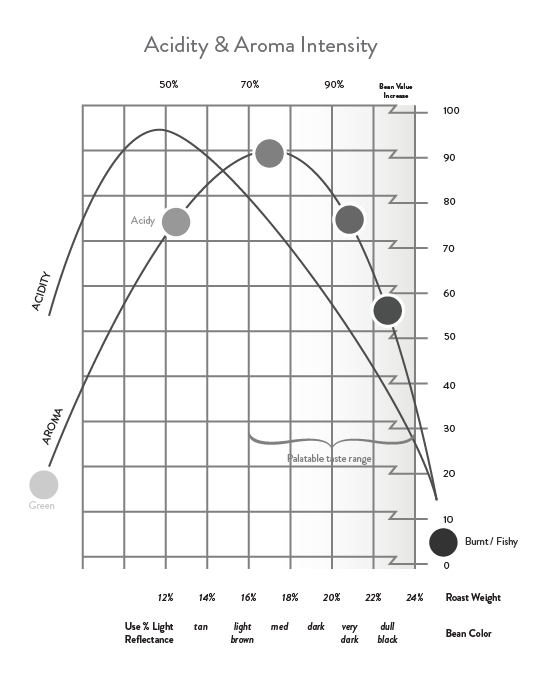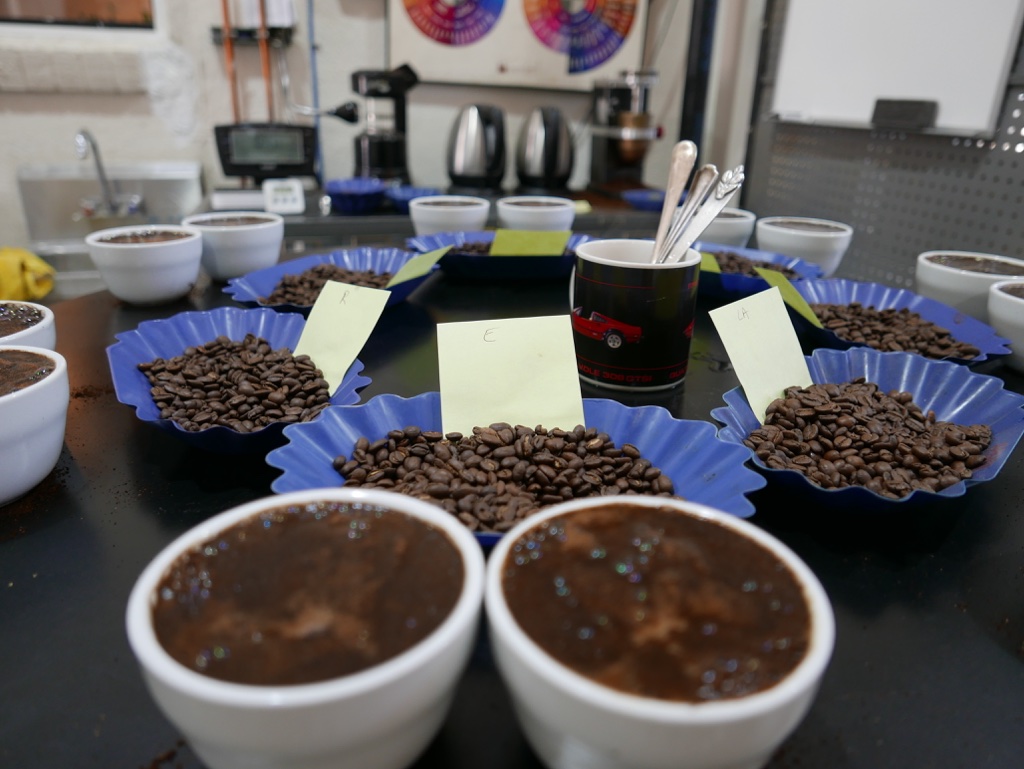Acidity is the bright, dry sensation that enlivens the taste of coffee.
Many coffee drinkers have a negative association with coffee acidity. Coffee that’s too acidic can be soury and spark unpleasant, edgy bodily sensations, or cause some people to experience digestive issues. For this reason, many seek out “low acid” coffees or experiment with brew methods that decrease acidity, often discovering that darker roast coffee has less acidity than lighter roast coffee. But to coffee professionals, acidity is an important indicator of coffee quality.
Average pH in coffee is 5 (for comparison neutral is 7, vinegar is 3, and lemon is 2). However, perceived acidity and pH do not always correlate. A coffee’s perceived acidity is a combination of factors: the roasting device, roast degree, and the type of acidity, combined with the brewing method.
When coffee professionals are evaluating coffee there are a number of factors they must consider. Is it clean? Is there no ferment or mold? Is it free of defects? Is it uniform? Is it fresh? To evaluate coffee for cup quality one of the important elements is a coffee’s acidity.
Coffee acidity for coffee professionals is a reflection on crop quality. Historically, acidity was evaluated on a pass/fail basis. Good acidity indicates that the coffee was grown and processed correctly and that the coffee is fresh and free from defects that may mar its flavor.
Coffee professionals use an evaluative method called cupping. Samples of coffee are roasted to a specific light roast, a trade roast, that emphasizes the acidity in a sample. Trade roasts are meant to amplify any defects a coffee may have, rather than reflect the flavor a coffee may have in production roasts. It is an evaluative tool. Once a coffee passes this evaluation it is profiled to determine its best roast for production. Here a coffee is evaluated for its ideal flavor balance.
Ideally, a good coffee will display a sweet, tart, citric acidity resembling fresh lemon, indicating that the coffee is fresh, clean and well prepared. This type of acidity presents a pleasant lively sensation to the coffee. Without it, coffee tastes bland and flavor is muted. Coffees that display good citric acidity are from Arabica coffee trees, grown at elevation under a canopy of shade, and are wet processed in a timely manner.
 There are a number of other acids that contribute to coffee’s flavor, for better or worse. The presence of these acids in excess is due to issues relating to a coffee’s growing, production, roasting and brewing. Other acids in coffee include:
There are a number of other acids that contribute to coffee’s flavor, for better or worse. The presence of these acids in excess is due to issues relating to a coffee’s growing, production, roasting and brewing. Other acids in coffee include:
- Chlorogenic acid – From growing. Part of the plant’s defense. High stressed and Robusta coffee trees will display excess. Has a harsh, bitter character.
- Malic acid – From growing. Typical in full sun grown coffee. Due to the plant’s respiration from hot daytime temperatures to colder night time temperatures. Has a lingering apple skin character.
- Acetic acid – From processing. Too long in fermentation tank or temperature too high in tank. Has an unpleasant vinegary character.
- Quinic & Caffetic acid – From roasting and brewing. It is the breakdown of chlorogenic acid resulting from too much time heat is applied to organic compounds. Too slow roasting or brewing. Has an unpleasant quinine character like tonic water.
- Buteric acid – From processing. Indicates ferment in the coffee bean. Has a rank sweetness resembling watermelon rind.
The prevalence of light roast coffees among many new roasting firms has led to a change in attitude about acidity in recent years. Since acidity dominates the flavor in light roasts, acidity is flavor for these firms. This has led to an opinion that all acidity is good, regardless of its source. Coffees that would have been rejected in the past are now often celebrated for their unique flavor. For some, light roast itself is a marker of quality, based on the mistaken notion that if acidity is flavor, more acidity is more flavor. Unfortunately, coffee that is predominantly acidic will invariably become sour as it cools.
If you are a person affected by too acidic coffee there are ways to avoid an unpleasant experience: Beware of coffees whose flavor descriptions are made up of various fruits. This is an indicator of light roast coffee where acidity dominates. Flavor descriptions such as strawberry, lime, apricot, apple, etc are all euphemisms for the acidic compounds as listed above.
Avoid coffees that are listed as natural, dry or honey processed. These are preparation methods that allow for excessive fermentation and acidulation to occur in the green beans. Look for wet-processed coffees as this method produces a cleaner more uniform flavor.
Generally speaking, acidity decreases in roasting. Darker roast coffees will display less acidity than lighter roasts. Coffee whose flavor descriptions are based on aromatic terms such as cocoa, spices, etc, indicate a darker roast. Don’t feel that you must immediately go to the darkest roast, however, even medium-dark roasts present less forward acidity and provide an excellent balance of flavor. Too dark a roast the coffee can taste bitter.
Finally, the brewing method can affect coffee’s acidity. Too slow a brewing method will produce excessive acidity – experienced as a unpleasant, soury-tart flavor from quinic acidulation – the worst example being percolated coffee. Leaving brewed coffee on a hot surface will also increase acidity in the brew.
At Kaladi, we believe that good acidity is an important indicator of coffee quality, but it shouldn’t dominate or ruin your experience. That’s why we select only shade-grown, wet processed Arabica coffees. With more efficient heat transference that rapidly drives off moisture in green coffee and reduces soury acids, our signature Air-Roaster roasts each bean to a specific temperature that brings out the best balance of flavor.
Less acidity, more aroma: that’s the Kaladi way.

